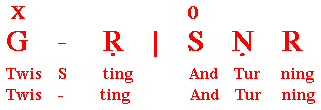Pandit Shiv Dayal Batish
Raga Manavati
Ashwin Batish and family Live
The UC Theater, Berkeley, California.
Meena Batish
Words by Ghalib
Music by S.D. Batish
Phone: (831) 423-1699

North India Sargam Notation System
by Ashwin Batish / S. D. BatishBefore you delve into the various articles in these issues, and in future issues, it is important that you learn to read, write and understand Indian music notation.
There are several different iterations of writing Indian music. It was a process India was unfamiliar with because music comes from a long lineage of oral traditions. In our musical works written in this magazine, we closely follow the Bhatkhande Notation system. There will be another article to explain the other systems of writing music although the differences are minor but can throw you off if you are unfamiliar with where they differ.
We will try to have audio sound files of our musical compositions to make it more understandable. But, this will not always be available, and besides, it is good :-) musical training to put yourself through...so don't shy away from it. It can be a bit tedious in the beginning but as your understanding grows so will your tolerance.
To help our Western students that are already familiar with Western Staff Notation, we have made an effort to make simultaneous use of Sargam and Western staff notations. The reason is that by having access to both, we hope it will teach the ways of one to the other.
The Sargam notation system listed here, is the one used in North India. I will deal with the Carnatic system in another article.
North Indian Sargam Notation
What the West calls an octave is called "Ashtak" in Indian music. (Asht meaning eight). But in music circles, we like to call the Indian "octave" by the term "Saptak" (Sapt meaning seven) for the seven non-repeated notes (in the octave system the tonic is repeated and hence forms the eight note of the octave). So keep this point in mind when learning ragas.
In the North Indian music system, we recognize 12 musically usable notes called swara. These are as follows

Memorize this set. All North Indian ragas are derived from these notes. N.I. music recognizes 7 shudha swara (shudha means pure or natural), four komal swara (flat notes) and one Tivar swara (sharp note)
The symbols are actually derived from the first letter of the ancient sanskrit note names which are
Sanskrit Sung Written Note Names as as -------------------------------- Shadaja Sa S Rishabha Re R Gandhar Ga G Madhyam Ma M Pancham Pa P Dhaivata Dha D Nishadha Ni N
Here are some key symbols used
| - a vertical bar separates the rhythmic vibhags (measures) of a composition. This is analogous to the Western "Bar" for instance in a six beat cycle of Dadra Taal, there are two vibhags. The music is written as follows

- (hyphen): This is used to denote a rest in the composition.
In instrumental music this hyphen can even denote a continuation of the previous note. If lyrics were to be written underneath this rest, the symbol "S" is used to denote this rest or continuation of the previous note. Here is an example of the use of both these types of rests.

Some composers will opt to just use the hyphen instead of the "S" perhaps to avoid confusion. In most of our works we have followed the hyphen rule.
(P) - Brackets around a note denotes a special trill. Trill is analogous to the term "Gamak" in Indian music. It means ornamentation. In this example, the progression is D P M P. The point to note here is that to qualify as a grace note this movement should be played very quickly. In medium tempo, for instance, all four notes should be played in one or half a matra (beat).
RS - A superscript letter is used to denote "Kan Swara" or grace notes. In this example R is the grace note and S in the note that receives it. Here is an audio example of this. Kan swara are also a form of Gamak.
Issues:
1 • 2 • 3 • 4 • 5 • 6 • 7 • 8 • 9
|
|
|
email: info [at] batish.com
copyright ©1995 - 2003 Batish Institute. All rights reserved. Intended For Personal Use Only. No part of the information here may be reproduced or utilized in any form or by any means, electronic or mechanical, including photocopying and recording, or by any information and storage retrieval system, without specific written permission from the Batish family.